Email Marketing
The Welcome Email Series: Start Right with New Subscribers
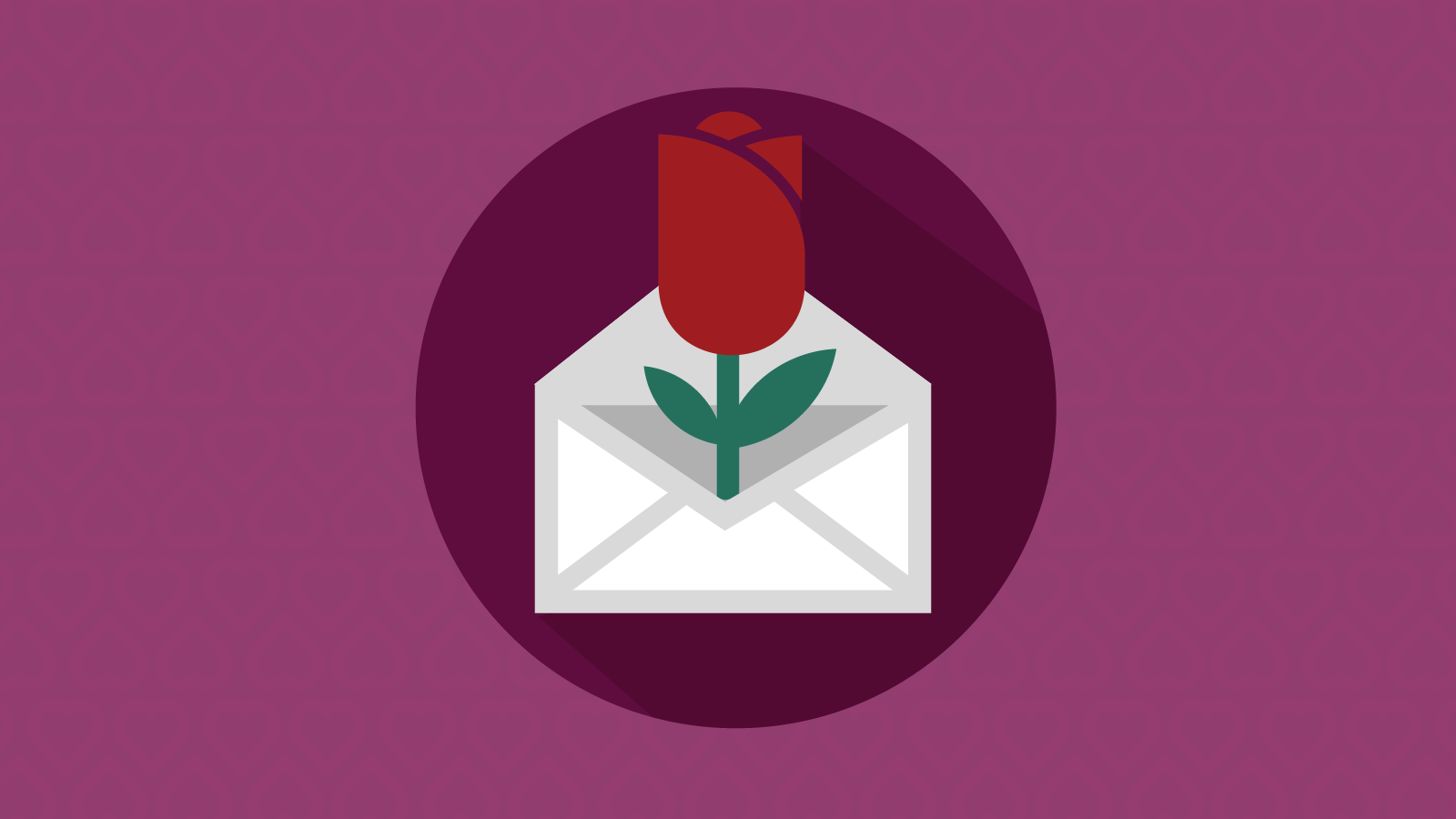
Email Marketing

We always remember our firsts: first dances, first dates,
first kisses, first marriages. They represent the beginning of something
new. That’s why the first email you send to new subscribers is super important.
Okay, maybe they won’t experience the same fireworks as a first kiss, but your welcome email series sets the stage for what’s to come. Make no mistake, when someone hands you their email address, they are entering into a new relationship with your brand.
With that in mind, let’s take a look at the strategies behind an effective welcome email series from the perspective of dating.
In our exclusive report, Optimizing Your Email Marketing Strategy, a survey of best-in-class marketers identified the welcome email series as the most engaging type of automation. When asked to pick the top three email automations, 54% chose welcome emails.
Email marketing benchmarks from GetResponse back up those survey results. It found welcome emails have an 86% open rate, a nearly 25% click rate, and a click-to-open rate of almost 29%.
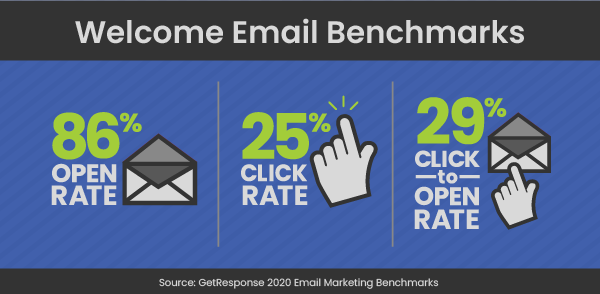
That makes a lot of sense. A new subscriber’s interest is high and they’re curious about this new stuff coming to their email inbox.
New relationships are like that too. Imagine you gave your phone number to someone you just met. You’ll be anticipating their first call or text. When it arrives, you’ll probably analyze and critique what they say as well as when and how they contacted you.
That’s why it’s so important for email marketers to start off on the right foot. But how can your welcome email series accomplish that?
When someone does nothing but talk about themselves on the first date, it’s a huge turn-off. Chances are, that person won’t be getting a second date.
The same thing can happen with a welcome email series. Use those emails to do nothing but talk about your company’s story, push your offers, or brag about your awards and you’re likely to lose new contacts. It’s one of the many reasons people unsubscribe. Or, they simply stop opening your emails, just like you’d ignore texts from someone who’s a self-centered jerk.
Of course, your welcome emails do need to let new subscribers know what you’re all about. The trick is … you need to frame things the right way. When you do tell your story, make sure it’s relatable — just like finding common interests on a first date.
Why should new contacts trust you? Show them they made the right decision when they subscribed. In what ways will the services you offer or the products you sell add value to their lives? Talk about benefits not just features. How does your company’s mission support the subscriber’s values and beliefs?
This welcome email example from Help for Heroes Shop makes new subscribers feel included as part of a team. The messaging aligns the brand’s mission with the values and interests of the potential customer. It also lets the recipient know what they can expect in future emails from the brand. Sure, they’re pushing t-shirts. But it doesn’t feel pushy, does it?

You wouldn’t go on a first date wearing your favorite comfy sweatpants with a hole in the rear-end. But you wouldn’t show up wearing a tuxedo either (unless that’s your thing). Instead, you’d pick an outfit that reflects who you are and how you want to be perceived.
Design and copywriting decisions for a welcome email series work in much the same way. So, how should you dress up your welcome emails?
You want to design emails in a way that authentically reflects your brand. Stick to your style guide and try to keep the email experience cohesive with the look and feel of campaigns that new subscribers may receive in the future.
Keep brand voice and tone in mind when writing welcome emails too. If your brand is casual and quirky, feel free to crack a joke or two to show some personality. Just don’t prioritize clever writing over clarity in emails. If your company is passionate about something, let that come through in the copy. Just don’t come off as too angry or use too much fear marketing.
One glance at the email below and you immediately know it’s from Target. The logo isn’t huge at all, but the retail brand’s color scheme and iconography are very recognizable.

The last thing you want to be in a welcome email series is boring and forgettable.
Excitement and adventure can fast-track new relationships. That’s why reality shows like The Bachelor and The Bachelorette send people on those adrenaline-pumping excursions. They’re a recipe for romance.
Sharing your most exciting content in a welcome series is a great way to engage new subscribers. It’s like sharing your craziest personal story with a first date, and it gives your brand’s personality the chance to shine.
It’s called a welcome email series because you should be sending more than just one message.
Most welcome automations have between three and six different emails in them, and the automation plays out over a week or two. The right number of welcome emails and when you send them is going to be very dependent on your industry, your target audience, and what you’re offering. If it’s a major purchase that requires consideration, the sequence may need to be longer than that of an impulsive eCommerce purchase.
When you choose what information and content to include in those first few emails, think about it the same way you’d plan a perfect first date.
You wouldn’t take someone to a movie and call it a night. You’d strategically pick a few activities that would allow you to spend time getting to know each other: First coffee, then a walk in the park, then a matinee followed by a nice dinner.
Your welcome email series could follow a flow like this: First thank them for subscribing, then send them your latest eBook, then talk about a problem you could help them solve, and finally, wrap things up with a special offer. Just be careful about selling too soon.
Don’t make new contacts wait long for that first email either. After subscribing, it should hit their inbox as soon as possible. Then you can hit the pause button for a day or two. You don’t want to be annoying or seem desperate.
One date shows up at the door with a bouquet of fresh-cut flowers. Another pulls into the driveway and honks the horn to announce his arrival. Which one do you think will have a better first date?
Instead of immediately using welcome emails to push subscribers toward making a purchase, consider giving something away. What kinds of gifts can you offer new subscribers?
Since you’ve already got their contact info, you could send them direct downloads to access gated premium content on your site. Free trials, complimentary consultations, and first-timer discounts are all possibilities.
Or you could surprise and delight subscribers with something fun and unexpected: a lighthearted GIF, an interactive game, some friendly encouragement from the CEO, or a sincere offer to help them out in some way.
This welcome email example from Help Scout makes it very clear what a subscriber gets with a limited free trial. But it also provides helpful info and links so that the prospect gets the most out of their free trial experience.
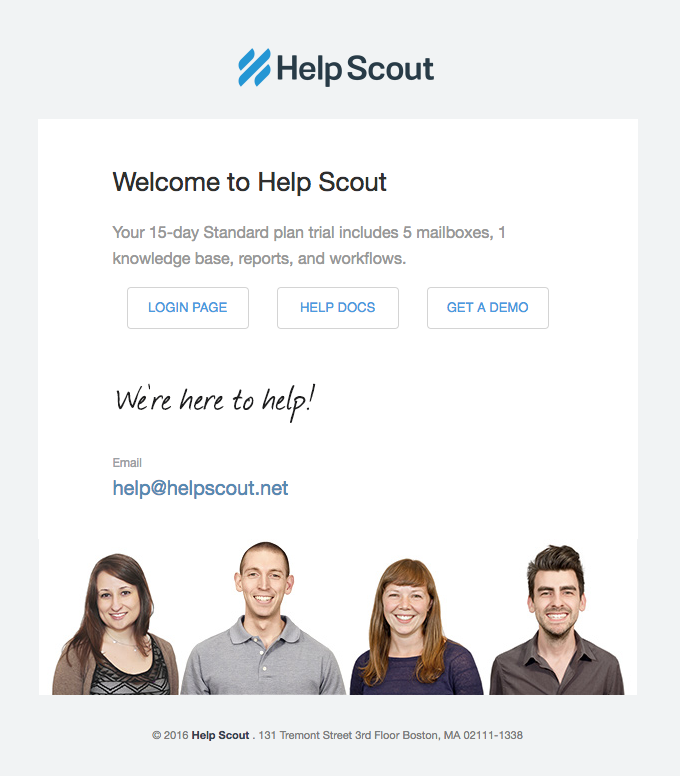
Imagine being on a date and forgetting the name of the person you asked out. Talk about awkward! The only thing worse than forgetting is guessing wrong.
Don’t expect to get results if you use the wrong name when personalizing subject lines or content in a welcome series. Make sure your data is accurate!
Still, email personalization offers many more opportunities than potential disasters, especially when you’re talking with new customers and contacts. The more sophisticated your email program is, the more you can do to personalize the welcome email experience.
If your CRM can show you how a new subscriber converted, you may be able to retrace their journey. CRM data can show you which pages they visited and what content they consumed. Use that info to create customized welcome experiences for different types of subscribers.
When things go well on a first date, you may want to find out what other people you know think about them. So, you get opinions from friends and family members you trust.
You can help subscribers do something similar in your welcome series. Near the end of the automation is the perfect place to send along customer testimonials and positive reviews.
The Goodfor Company does this effectively with a few simple customer comments before turning the focus back to the subscriber and offering a clear call-to-action.
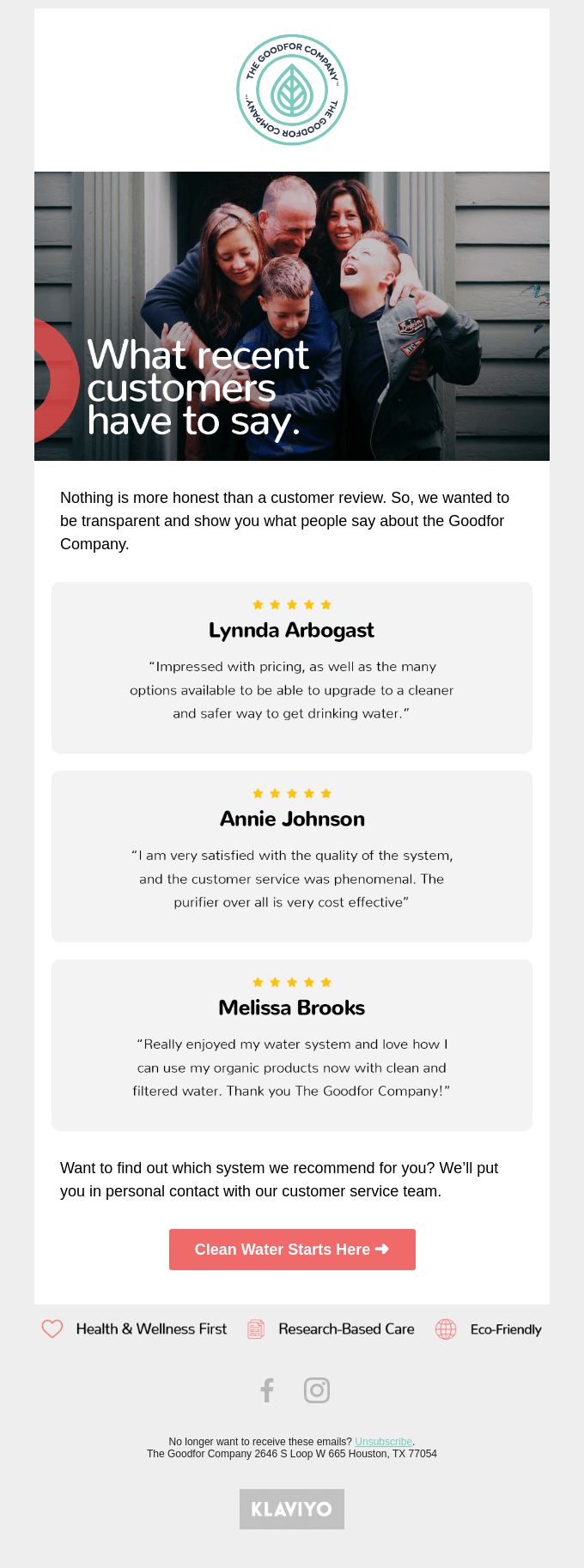
It works the other way too. There may be people in your organization who should be introduced to your new subscribers. For example, they could be interested in receiving strategic thought leadership content from a subject matter expert who matches their interests.
In cases like that, using “friendly froms” with the names of your in-house experts is a good way to make those emails feel more personal and authentic. Just make sure it’s still clear that the email is from your brand and not a random stranger.
The welcome email series comes at a crucial point in the customer journey. If someone ends up on your email list, it usually means they’ve explored your offerings and content enough to know they want to hear more from you.
They are on the verge of becoming buyers. That’s why your email marketing game needs to be at its best in these welcome automations. Think very carefully about what will be most valuable to your buyer personas at this point in their path to purchase. How can your welcome emails align with the customer journey?
At some point, you’ll need to ask the subscriber to take the next step in that journey.
In a dating relationship, that could mean asking someone to go steady and eventually proposing marriage. In email marketing, it could mean asking them to sign up for a demo, create an account, or provide one last chance to use their introductory discount.
Website builder, Wix, uses a welcome email to make it very clear what it wants subscribers to do. But notice, they aren’t pushing a purchase. They are encouraging the subscriber to take the next step on the journey to building their own website.
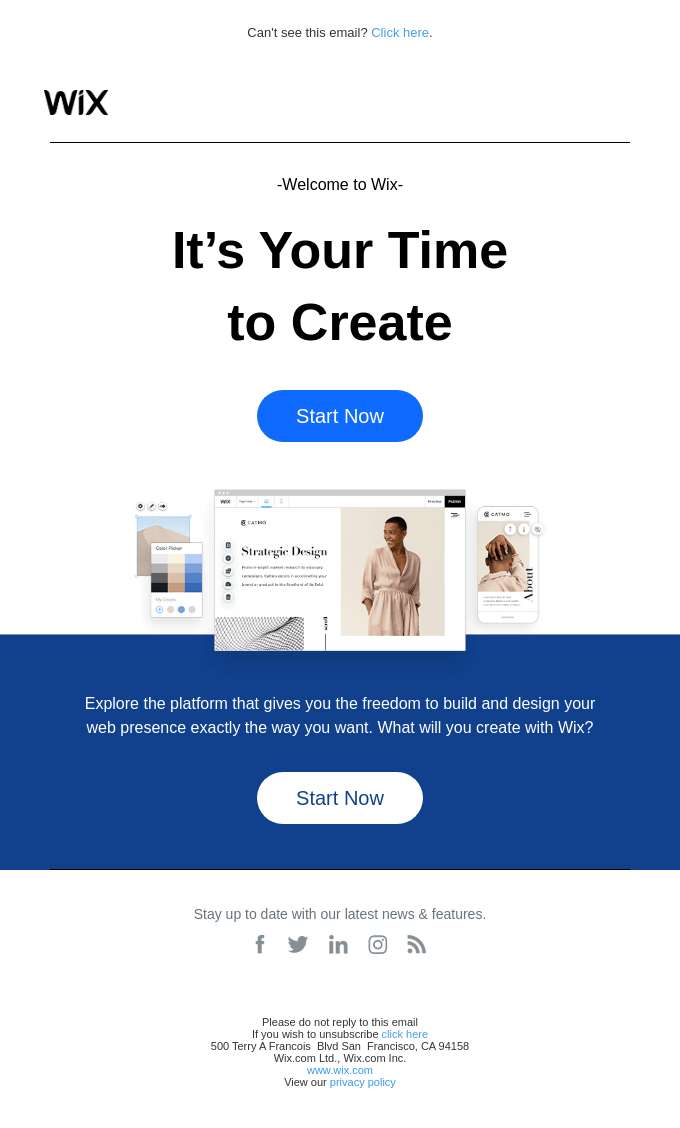
At the end of the welcome email series, a few different things can happen:
For B2B brands, this could mean you need to put them into an onboarding series. For B2C brands, it could mean you start tracking purchase habits to help make your emails more relevant and personalized.
Get advice on what kinds of automations to use next in our articles on B2B email automations and B2C email automation campaign ideas.
In this case, don’t give up. You should continue providing value with your emails and nurture them along their customer journey. They’ll convert when the time is right. Some relationships take time to bloom.
When this happens, you can try putting them into a re-engagement automation. They could be playing “hard to get,” but it may also be a lost cause. Don’t let inactive subscribers languish in your email lists. If you fail to follow best practices for list hygiene, it can end up hurting deliverability.
Sometimes, they’re just not that into you and it doesn’t work out. Relationships end and people break up. Be sure you’re giving people an out. Don’t make it too hard to unsubscribe from your emails. Give them some space. Maybe they’ll come back someday, once they realize what they’re missing.
You only have one chance to make a good first impression! (Come on, you knew we were going to use that cliché at some point, right?)
A welcome email with typos, accessibility issues, or email client rendering problems is not the best way to start things off. And an email with deliverability issues that doesn’t even make it to the inbox won’t do anything at all.
Test every campaign, including welcome automations, using Email on Acid’s pre-send email checklist. We’re like that final check in the mirror before a date when you spot a piece of spinach stuck in your teeth. Give us a try and start delivering email perfection!